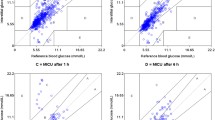Abstract
Microdialysis, that is the sampling of interstitial fluid via semi-permeable tubes, has been shown to be suitable for detecting ischemic changes e.g. in brain and heart tissue. The purpose of the present study was to investigate the possibility of monitoring with subcutaneous microdialysis peri-operative metabolic sequelae of elective abdominal aortic surgery. In 22 patients microdialysis catheters were inserted subcutaneously in the lower leg as well as the shoulder serving as a reference topographic region. Lactate, pyruvate and glycerol, which indicate ischemia or reperfusion, were measured. We observed severe metabolic changes within the interstitial fluid of the lower extremity during ischemia followed by normalization during reperfusion. Despite high interstitial concentrations of lactate and glycerol indicating severe ischemia during clamping of the abdominal aorta these parameters returned to pre-operative values within 2 hrs after declamping and all patients recovered completely. Objective.Information about the metabolic state of the lower extremity during and after infrarenal aortic aneurysm repair should modify peri-operative treatment. The aim of the study was to evaluate whether microdialysis of the subcutaneous tissue reflects metabolic changes during ischemia and reperfusion. Lactate, pyruvate and glycerol concentrations were measured in the subcutaneous tissue of the lower extremity and compared to the microdialysis measurements from shoulder subcutaneous tissue. Method.In 22 patients microdialysis catheters were inserted preoperatively in the subcutaneous space of the left shoulder and the left calf. Samples were taken at timed intervals before, during and after clamping of the abdominal aorta. Results.The subcutaneous glycerol concentration of the calf was increased during the clamping period from initially 68 ± 11 µM up to 182 ± 27 µM (p< 0.05); the lactate/pyruvate (L/P) ratio was increased eightfold. After declamping these values normalized to baseline. Microdialysis measurements of the shoulder showed no prominent changes during the entire course of observation. Conclusions.Subcutaneous microdialysis was able to detect metabolic changes due to ischemia during clamping of the abdominal aorta as well as reperfusion there after. It is a suitable technique to monitor the peri-operative course of the dependent tissue after abdominal aortic vascular surgery.
Similar content being viewed by others
REFERENCES
Hagstrom TE, Enoksson S, Moberg E et al. Absolute concentrations of glycerol and lactate in human skeletal muscle, adipose tissue, and blood. Am J Physiol 1997; 273: E584-E592
Stjernström H, Karlson T, Ungerstedt U, Hillered L. Chemical monitoring of intensive care patients using intravenous micro dialysis. Intensive Care Med 1993; 19: 423-428
MacLean LD, Sinoway L, Leuenberger U. Systemic hypoxia elevates skeletal muscle interstitial adenosine levals in humans. Circulation 1998; 98: 1990-1992
Oldner A, Goiny M, Rudehill A et al. Tissue hypoxanthine re£ects gut vulnerability in porcine endotoxin shock [see comments]. Crit Care Med 1999; 27: 790-797
Sirsjo A, Arstrand K, Kagedal B et al. In situ microdialysis for monitoring of extracellular glutathione levels in normal, ischemic and post-ischemic skeletal muscle. Free Radic Res 1996; 25: 385-391
Kett-White R, Hutchinson PJ, Al-Rawi PG, Czosnyka M, Gupta AK, Pickard JD, Kirkpatrick PJ. Cerebral oxygen and microdialysis monitoring during aneurysm surgery: Effects of blood pressure, cerebrospinal fluid drainage, and temporary clipping on infarction. J Neurosurg 2002; 96: 1013-1019
Ungerstedt U. Microdialysis-A new technique for monitoring local tissue events in the clinic. Acta Anaesthesiol Scand Suppl 1997; 110: 123
Haljamae H. The pathophysiology of shock. Acta Anaesthesiol Scand Suppl 1993; 98: 3-6
Weil MH, Gazmuri RJ. Shock: New developments in the management of shock. Applied Cardiopulmonary Pathophysiology 1991; 4: 103-107
Inazawa K. [The change of polymorphonuclear elastase releasing from ischemic skeleton muscles after reperfusion]. Nippon Geka Gakkai Zasshi 1995; 96: 430-438
Fukuda S, Taga K, Tanaka T et al. Relationship between tissue ischemia and venous endothelin-1 during abdominal aortic aneurysm surgery. J Cardiothorac Vasc Anesth 1995; 9: 510-514
Formigli L, Ibba ML, Tani A et al. Vitamin E prevents neutrophil accumulation and attenuates tissue damage in ischemic-reperfused human skeletal muscle. Histol Histopathol 1997; 12: 663-669
Weil MH, Afifi AA. Experimental and clinical studies on lactate and pyruvate as indicators of the severity of acute circulatory failure (shock). Circulation 1970; 41: 989-1001
Ballotta E, Da Giau G, Bottio T, Toniato A. Elective surgery for small abdominal aortic aneurysms [see comments]. Cardiovasc Surg 1999; 7: 495-502
Johnston KW. Multicenter prospective study of nonruptured abdominal aortic aneurysm. Part II. Variables predicting morbidity and mortality. J Vasc Surg 1989; 9: 437-447
Guilini SM, Bonardelli S, Portolani N et al. Suprarenal aortic cross-clamping in elective abdominal aortic aneurysm surgery. Eur J Vas Endovasc Surg 2000; 20: 286-289
Müller M. Microdialysis-Science, medicine and the future. BMJ 2002; 324: 588-591
Author information
Authors and Affiliations
Rights and permissions
About this article
Cite this article
Bahlmann, L., Wagner, K., Heringlake, M. et al. Subcutaneous Microdialysis for Metabolic Monitoring in Abdominal Aortic Surgery. J Clin Monit Comput 17, 309–312 (2002). https://doi.org/10.1023/A:1021284608837
Issue Date:
DOI: https://doi.org/10.1023/A:1021284608837




